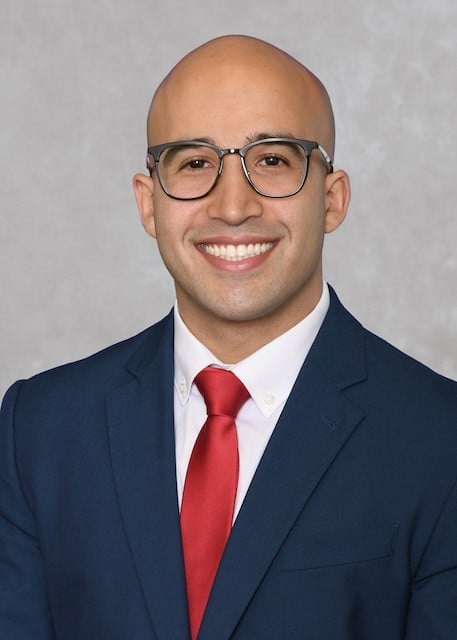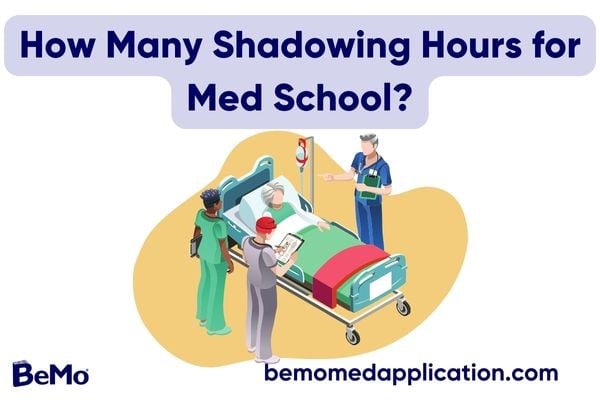Many applicants wonder how many shadowing hours for medical school are required. While most schools have specific thresholds for quantitative metrics like GPA and MCAT scores, the ideal amount and type of shadowing experience is less defined but just as important in making you a competitive candidate. In this blog you will learn how many shadowing hours you should gain before you apply to medical school.
>>Want us to help you get accepted? Schedule a free initial consultation here <<
Listen to the blog!
Optimal Shadowing Hours for Medical School: How Much is Enough?
The answer to this isn’t black and white, but if you want to put a number on it, around 100-120 hours is a good ideal range.
If your program suggests (or requires) a range of hours, it’s always best to aim at the top end.
We’ve broken this down with the help of our consultants:
Is There a Specific Shadowing Requirement?
There is no clear-cut number of hours, and most schools will simply require or recommend shadowing without a number attached. Some schools won’t have any requirements for shadowing at all, which can throw applicants for a loop.
On the flip side, some schools will have specific shadowing requirements, e.g., 15-30 hours, 50+, or even 120 hours…so it’s imperative that you check the particular medical school requirements of the schools to which you’re applying.
One of our consultants shared her experience and perspective:
“I had 300 hours of shadowing and 100 clinical hours required. In my opinion, next to MCAT and GPA, experience with patients comes second [in terms of importance for med school applications].” – Dr. Monica Taneja, MD, University of Maryland School of Medicine
It may sound like a lot, but shadowing one doctor for one day will be approximately 10 hours, so if you can shadow multiple doctors for a total of 10 days spread over time, (even over a year or so if you start early), then you can easily hit your target.
Another consultant, Dr. Sona Nuguri had similar requirements.
“I learned a lot about the team dynamics. I think [shadowing and clinical] experiences are extremely important! Students are not exposed to the reality of medicine and how emotionally and physically challenging it is. It can allow them to be in the shoes of the physician and experience the drawbacks of the [profession].” - Dr. Sona Nuguri, MD
Do You Still Need Shadowing Hours if They Aren’t Required?
Experience is ALWAYS an asset that reflects positively on you as an applicant; even if not required. In the words of our consultant, Dr. Neel Mistry:
“Any (clinical or shadowing) experience is not always mandatory. If you do not have experience, it does not automatically make you a weaker applicant. However, the experience is an asset.”- Dr. Neel Mistry, MD
How Can I Ask to Shadow a Doctor?
It can be a tough task to ask for a shadowing opportunity! But it’s imperative that you do so with confidence and a professional approach. We’ve written a blog that breaks down how to ask to shadow a doctor that dives into the topic a bit deeper!
Want to know how to ask to shadow a doctor? Check out this video!
Should I Get Experience Shadowing in a Specific Specialty?
Yes! You may wish to shadow doctors in various specialties; you don’t need to shift to a new specialty each time you shadow, but it is a great opportunity to get some exposure to the various types of workdays that doctors experience.
In Dr. Nuguri’s case:
"I shadowed a pediatric cardiologist, cardiologist, gastroenterologist, and a general surgeon. I volunteered at a free clinic. I learned a lot about the emotional vulnerability patients come with and how to treat different groups of people (acute cases, children, elderly, etc.)”
It goes without saying day for a family medicine specialist differs wildly from a day in emergency medicine, just as cardiology differs from neurosurgery, and so on. There’s no substitute for the kind of direct observation that good shadowing experiences provide, so cast a wide net and use it to give yourself as complete a sense as possible of your potential career paths. Create a short list of specializations that interest you and see if you can get shadowing experience for at least three of these!
What Is the Difference Between Shadowing and Clinical Experience?
When you’re eager to get into med school, it's essential to understand the differences between shadowing and clinical hours and experience. For many applicants, it’s crucial that you have experience with both!
Unsure of the difference? Here’s a basic breakdown:
- Clinical Experience involves active participation in a medical team, patient interaction, and gaining hands-on exposure to healthcare, helping you confirm your commitment to medicine.
- Shadowing is more passive; you observe a doctor's daily routine, gaining insight into their work without direct patient contact. This helps you understand the realities of being a physician and shows admissions committees your preparation.
Virtual Shadowing: Is the Experience Legitimate?
With the rise of digitalization, virtual shadowing has become a viable option in medical school applications. Most medical schools now accept virtual shadowing, treating it similarly to in-person experiences. However, the quality of the experience matters. Engaging in more interactive virtual shadowing is preferable to passive observation. While it's generally accepted, it's wise to check with specific schools about their policies. Even if not counted as one of your medical school prerequisites, virtual shadowing can still enhance your application as a healthcare-related extracurricular.
Want to learn how to gain clinical experience? Check out our infographic below:
How Do Shadowing Experiences Contribute to Your Medical School Application?
The depth of your insights and reflections about the shadowing hours is a critical factor for admissions committees. Ultimately, what you get – and how well you articulate what you get – from shadowing experiences is far more important than the specific number of hours (unless the schools to which you’re applying do have specific hours requirements). As our consultant, Dr. Taneja said, “[Shadowing and clinical experience] gave me a lot of unique talking points on my application.”
Use your shadowing experience in your AMCAS work and activities, AMCAS most meaningful experiences, autobiographical sketch, personal statement, and/or medical school secondary essays, as a way of highlighting your curiosity and investment into medicine as a career. Reflect on your experience as a way of demonstrating some key qualities about yourself. Take note of particularly meaningful events or interactions you witnessed and draw on these as inspiration for why you want to live the kind of life you had the privilege of observing.
Additionally, with the greater push for diversity and inclusion in medical school, if you had specific circumstances that directly influenced your decision to seek out virtual experiences over in-person experiences, make sure you include this information in your application. The ideal place to discuss this topic in detail would be your medical school diversity secondary essay.
For all of your experiences, provide all the required details including the name and credentials of the physician you shadowed. Focus on the specifics of what you observed, what you learned, and how it contributed to your understanding of and passion about the medical profession. Include information about the number of hours you completed, the technology used to access the experience, and your own role in the process (even if it was a passive one).
FAQs
1. How many hours of shadowing experience do I need?
The requirements vary between programs (so, it’s essential that you check with them), but generally speaking, 100-120 hours is what we’d recommend!
2. How do I ensure a good shadowing experience?
Prioritize professionalism: arrive early, dress appropriately, and understand the doctor’s specialty. Stay engaged without drawing focus away from patient care. If asked to leave during sensitive situations, do so respectfully. Show genuine interest in learning, not just fulfilling a requirement. Your motivation to help others should be clear, as doctors will notice your dedication. Treat the experience as valuable in its own right, aligning with your intrinsic drive to make a positive impact in medicine.
3. Why is shadowing a requirement?
Medical schools want to know that medicine is a vocation as opposed to simply an occupation for you. Assuring them that you understand the everyday responsibilities and activities of a practicing doctor is what shadowing is all about.
4. How do I learn about my chosen schools' shadowing requirement?
The first place you should check is their website, of course, specifically the sections relating to admissions to their medical program. The AAMC's Medical School Admissions Requirements (MSAR) site is also a great resource.
5. What does shadowing a physician entail?
Shadowing involves following a physician for at least one full day as an observer. You will not be asked to participate in any procedures, although you may be invited to interact with patients to an extremely limited degree.
6. Is paid clinical experience better than shadowing?
Not necessarily. If a school requires shadowing specifically then that's exactly what they want, and you should do all you can to meet that requirement. Paid clinical experiences can teach you a great deal about how to actively participate in medical environments, but shadowing is about improving your sense of personal context and understanding of the profession.
7. If I'm a Canadian applicant to U.S. schools, do I need to fulfill this requirement?
Yes! Even though it's often harder to arrange shadowing experiences in Canada, you should try to do so. Admissions committees may be more understanding if you simply cannot fulfill a shadowing requirement as a Canadian student, but unless it's truly impossible for you we recommend at least some shadowing experience. Check out our blog on Canadian-friendly medical schools in the U.S. for more discussion on how to navigate applying to schools South of the border.
8. How do I ask to shadow a doctor?
Begin by determining what specializations you're interested in and gather contact information for physicians in those specialties. Ask, politely, at least a month ahead of when you’d like to shadow them, make your schedule as amenable to theirs as possible, and be respectful if they decline your request.
9. Can I participate in virtual shadowing? Will it count towards my shadowing hours?
Absolutely! Since shadowing is a passive form of learning, you do not actually have to be present for the doctor-patient interactions.
10. How can I overcome challenges securing a shadowing opportunity?
Securing shadowing hours can be tough due to limited opportunities and logistical challenges. Start early, reach out broadly to hospitals and professionals, and consider virtual shadowing if in-person options are scarce. Networking through pre-med organizations or professors can also help you find valuable shadowing experiences.

